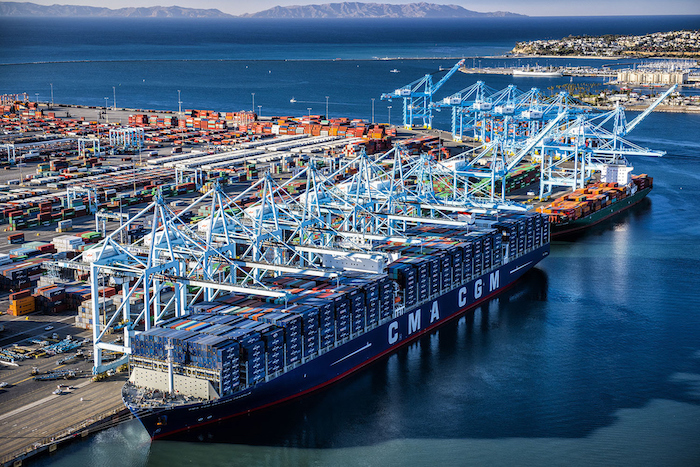It’s rare to see workers fight back against automation taking their jobs, but it’s useful for them to have a union that actually helps its clients. That’s what has been going on in the LA docks, where automation has been a source of contention for several years.
Unfortunately for the workers, the containerized shipping industry lends itself very easily to automation: its uniform boxes go smoothly from enormous ocean carriers through the ports to trucks which deliver Asian-produced merchandise to American consumers.
Below, the world’s largest container ship, the quarter-mile-long OMA CGM Benjamin Franklin which can carry 18,000 containers, is shown docked in the Port of Los Angeles.

The enormity of Pacific trade is enabled in part by the efficiency of containerized shipping, and roboticized ports are an important cog in the global money-making machine. Having driverless electric cargo trucks is apparently seen by the top office brains as speeding up the process and cutting the large paychecks of workers — funny how the captains of industry forget that well-paid employees are also big-spending shoppers.
Below, a Detroit paper reprinted the LA Times article posted below:
Dockworkers battle driverless trucks plan, Margot Roosevelt, Los Angeles Times, March 22, 2019
Los Angeles – A fierce struggle over automation has erupted at the Port of Los Angeles, as local union officials representing some 12,000 dockworkers demand that one of the world’s largest shipping firms abandon a plan to introduce driverless electric cargo trucks.
Shouting, whistling and jeering, more than 1,200 union members, local business owners and community activists packed a four-hour hearing Thursday before the Los Angeles Board of Harbor Commissioners. The board voted to postpone a construction permit for the automated system after an offer by Mayor Eric Garcetti to mediate the dispute.
“The decision before the board may have far-reaching impacts on the pace of automation at our port and could define how the port will compete and sustain jobs into the foreseeable future,” Garcetti wrote in a letter unveiled at the hearing.
The mayor called for a 28-day delay in deciding on the permit, adding that negotiations “should serve as the basis of a new task force to explore automation and its impacts on the future of the Port of Los Angeles and others across the state.”
Port automation dates to the 1960s, when dockworker unions agreed to the introduction of containers, and consequent job losses, in exchange for higher pay and benefits. Today a typical full-time Southern California longshore worker earns more than $100,000 a year. But thousands of so-called “casuals,” who are not yet registered union members, earn far less, are eligible only for part-time hours, and do not yet get health or retirement benefits.
A 2008 International Longshore and Warehouse Union contract, renewed in 2015, explicitly allowed West Coast ports to continue automating. Two large terminals – one at the Port of Long Beach and one in Los Angeles – have already introduced the driverless vehicles known as UTRs, or utility tractor rigs.
But automation at the 484-acre facility operated for Denmark’s Moller-Maersk by APM Terminals is prompting an uproar from local union members who are having second thoughts about the current contract and believe the permit will lead to automation across all 12 of the port complex’s terminals.
The struggle comes as Los Angeles and Long Beach, the busiest ports in the nation, are enjoying record cargo traffic, despite the threat of an escalating trade war with China. The twin ports handle a third of U.S. container traffic, but they have lost market share to facilities along the Gulf of Mexico and, since the widening of the Panama Canal, along the East Coast.
APM officials decline to say how many jobs will be eliminated if what they call “self-guided container handling equipment” is introduced. Union officials say hundreds are at stake. One in nine jobs in the five-county region is linked to commerce flowing through the port complex, according to port officials.
APM characterizes its proposed automated, battery-powered vehicles, which would replace diesel-fueled rigs, as a response to the port’s clean air rules. But union officials say APM could introduce manned electric vehicles instead. (Continues)